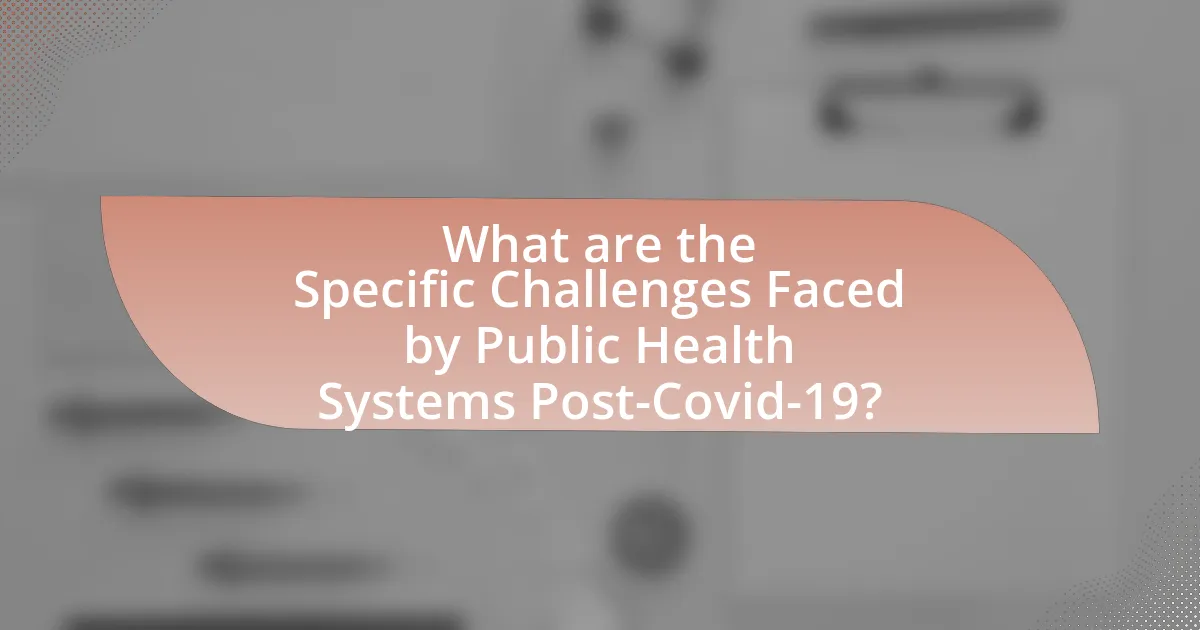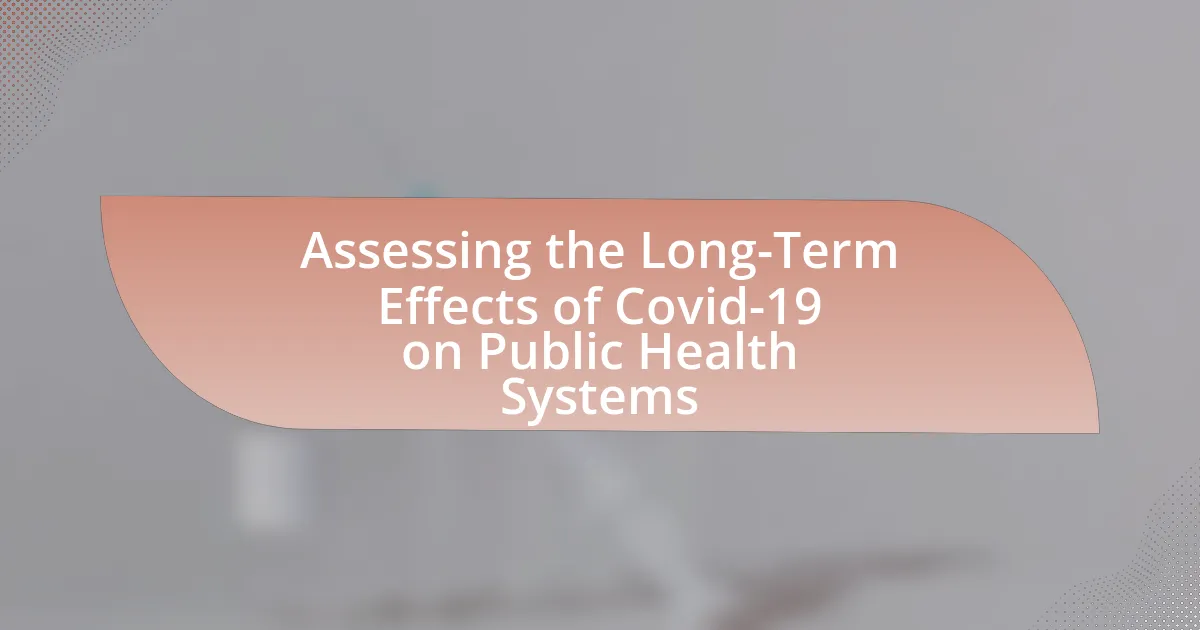The article focuses on assessing the long-term effects of Covid-19 on public health systems, highlighting significant challenges such as increased strain on healthcare resources, heightened mental health concerns, and accelerated digital health transformation. It discusses the impact on healthcare infrastructure, including hospital capacity and resource availability, as well as the implications for public health policy and funding. Additionally, the article examines changes in workforce dynamics, the evolution of telehealth, and the need for improved mental health services, ultimately emphasizing the importance of resilience and preparedness in public health systems for future health crises.

What are the Long-Term Effects of Covid-19 on Public Health Systems?
The long-term effects of Covid-19 on public health systems include increased strain on healthcare resources, heightened focus on mental health, and accelerated digital health transformation. Public health systems have faced unprecedented challenges, leading to resource depletion and workforce shortages, as evidenced by a 2021 report from the World Health Organization indicating that 90% of countries experienced disruptions in essential health services. Additionally, the pandemic has underscored the importance of mental health, with a significant rise in anxiety and depression rates reported by the Centers for Disease Control and Prevention, highlighting the need for integrated mental health services. Furthermore, the rapid adoption of telehealth services during the pandemic has prompted a lasting shift towards digital health solutions, with a study published in JAMA Health Forum showing that telehealth visits increased by over 150% in 2020 compared to previous years. These factors collectively illustrate the profound and lasting impact of Covid-19 on public health systems.
How has Covid-19 impacted healthcare infrastructure?
Covid-19 has significantly strained healthcare infrastructure worldwide, leading to increased demand for medical services and resources. Hospitals faced unprecedented patient surges, resulting in overcrowding and resource shortages, such as personal protective equipment and ventilators. According to a study published in The Lancet, healthcare systems in countries like Italy and the United States reported a 30% increase in hospital admissions during peak pandemic periods, highlighting the urgent need for expanded capacity. Additionally, the pandemic accelerated the adoption of telehealth services, with a 154% increase in telehealth visits reported in March 2020 compared to the previous year, demonstrating a shift in how healthcare is delivered. These changes underscore the long-term impacts on healthcare infrastructure, necessitating ongoing adaptations to meet future public health challenges.
What changes have been made to hospital capacities due to Covid-19?
Hospital capacities have been significantly increased due to Covid-19, with many facilities expanding their bed counts and repurposing areas to accommodate patients. For instance, in the United States, hospitals added approximately 77,000 beds during the pandemic peak to manage the surge in Covid-19 cases. Additionally, temporary field hospitals were established in various locations, such as convention centers and sports arenas, to provide extra capacity. These changes reflect a strategic response to the unprecedented demand for healthcare services during the pandemic, highlighting the need for adaptable healthcare infrastructure in public health systems.
How has the pandemic affected the availability of healthcare resources?
The pandemic has significantly reduced the availability of healthcare resources. Hospitals faced overwhelming patient loads, leading to shortages of beds, medical supplies, and personnel. For instance, a study published in the Journal of the American Medical Association reported that during peak COVID-19 surges, many hospitals operated at over 100% capacity, which strained their ability to provide routine and emergency care. Additionally, the World Health Organization indicated that 90% of countries experienced disruptions in essential health services, further illustrating the pandemic’s impact on healthcare resource availability.
What are the implications for public health policy?
The implications for public health policy include the need for enhanced preparedness and resilience in health systems. The COVID-19 pandemic has highlighted vulnerabilities in public health infrastructure, necessitating policies that prioritize rapid response capabilities, resource allocation, and inter-agency collaboration. For instance, a study by the World Health Organization in 2021 indicated that countries with robust public health frameworks were better able to manage the crisis, demonstrating the importance of investing in health system strengthening. Additionally, policies must address mental health and social determinants of health, as the pandemic has exacerbated existing disparities, underscoring the need for comprehensive approaches to health equity.
How has Covid-19 influenced public health funding and budget allocations?
Covid-19 has significantly increased public health funding and budget allocations globally. Governments have redirected resources to enhance healthcare infrastructure, expand testing capabilities, and support vaccine distribution, resulting in a surge of funding; for instance, the U.S. government allocated over $4 trillion in response to the pandemic, which included substantial investments in public health agencies. This shift reflects a recognition of the importance of robust public health systems, as evidenced by the World Health Organization’s report indicating that countries are now prioritizing health security and preparedness in their budgets, leading to long-term changes in funding strategies.
What new policies have emerged in response to the pandemic?
New policies that have emerged in response to the pandemic include enhanced public health surveillance systems, increased funding for healthcare infrastructure, and the implementation of telehealth services. Enhanced public health surveillance systems aim to improve the tracking of infectious diseases, as evidenced by the establishment of the CDC’s COVID-19 Data Tracker, which provides real-time data on cases and vaccinations. Increased funding for healthcare infrastructure has been seen in various countries, with the U.S. allocating over $1.9 trillion in the American Rescue Plan to bolster healthcare resources. Additionally, the widespread adoption of telehealth services has transformed patient care, with a report from McKinsey indicating that telehealth usage increased by 38 times from pre-pandemic levels, highlighting its role in maintaining healthcare access during lockdowns.
How has Covid-19 affected healthcare workforce dynamics?
Covid-19 has significantly altered healthcare workforce dynamics by increasing demand for healthcare services while simultaneously exacerbating staffing shortages. The pandemic led to a surge in patient volume, particularly in critical care, which strained existing healthcare personnel. According to a report from the World Health Organization, the global healthcare workforce faced a shortfall of 18 million workers by 2030, a situation worsened by the pandemic as many healthcare professionals experienced burnout and mental health challenges. Additionally, the shift towards telehealth services during Covid-19 has transformed job roles and required new skills, further complicating workforce dynamics.
What challenges has the healthcare workforce faced during and after the pandemic?
The healthcare workforce has faced significant challenges during and after the pandemic, including increased burnout, staffing shortages, and mental health issues. Burnout rates among healthcare professionals surged, with studies indicating that over 60% of nurses reported feeling exhausted and overwhelmed due to the demands of COVID-19 care. Staffing shortages became critical as many healthcare workers left the profession or reduced their hours, exacerbating the strain on remaining staff. Additionally, mental health issues, such as anxiety and depression, rose sharply among healthcare workers, with a survey revealing that nearly 50% of frontline workers experienced symptoms of psychological distress during the pandemic. These challenges have long-term implications for public health systems, affecting their ability to deliver care effectively.
How has the pandemic changed workforce training and development?
The pandemic has significantly transformed workforce training and development by accelerating the adoption of digital learning platforms and remote training methods. Organizations shifted from traditional in-person training to virtual formats, utilizing tools like webinars, online courses, and virtual simulations to ensure continuity in skill development. According to a report by McKinsey & Company, 70% of companies increased their investment in digital learning during the pandemic, highlighting a trend towards more flexible, accessible, and scalable training solutions. This shift not only enhanced the ability to train employees remotely but also emphasized the importance of upskilling and reskilling in response to rapidly changing job requirements in the post-pandemic economy.

What are the Specific Challenges Faced by Public Health Systems Post-Covid-19?
Public health systems face several specific challenges post-Covid-19, including resource allocation, workforce shortages, and mental health impacts. Resource allocation has become critical as funding and supplies are strained due to increased demand for healthcare services and the need for pandemic preparedness. Workforce shortages are exacerbated by burnout and attrition among healthcare professionals, with a study indicating that 47% of healthcare workers reported feeling burned out during the pandemic. Additionally, mental health issues have surged, with a significant rise in anxiety and depression among both the general population and healthcare workers, necessitating enhanced mental health services. These challenges highlight the need for systemic reforms to strengthen public health infrastructure and improve resilience against future health crises.
How has Covid-19 affected mental health services?
Covid-19 has significantly strained mental health services, leading to increased demand and reduced access to care. The pandemic resulted in a 25% increase in anxiety and depression globally, as reported by the World Health Organization. Many mental health facilities faced operational challenges, including staff shortages and the need to pivot to telehealth, which, while beneficial for some, created barriers for others lacking technology or internet access. Additionally, the focus on physical health during the pandemic often overshadowed mental health needs, exacerbating existing issues and delaying treatment for many individuals.
What increase in demand for mental health services has been observed?
The demand for mental health services has increased significantly, with a reported rise of 30% in service utilization since the onset of the COVID-19 pandemic. This surge is attributed to heightened levels of anxiety, depression, and stress experienced by individuals during and after lockdowns, as evidenced by studies from the World Health Organization and various mental health organizations. These findings highlight the urgent need for expanded mental health resources and support systems to address the growing mental health crisis.
How are public health systems addressing mental health needs post-pandemic?
Public health systems are addressing mental health needs post-pandemic by expanding access to mental health services, integrating mental health into primary care, and increasing funding for mental health programs. For instance, the Substance Abuse and Mental Health Services Administration (SAMHSA) reported a significant increase in telehealth services, which allowed for greater accessibility to mental health care during and after the pandemic. Additionally, many public health systems are implementing community-based initiatives aimed at reducing stigma and promoting mental wellness, as evidenced by the National Alliance on Mental Illness (NAMI) highlighting various state-level programs that focus on mental health education and support. These efforts are crucial in responding to the heightened mental health challenges observed during the pandemic, as studies indicate that anxiety and depression rates surged significantly among the population.
What role does technology play in the recovery of public health systems?
Technology plays a crucial role in the recovery of public health systems by enhancing data collection, improving communication, and facilitating telehealth services. For instance, the implementation of electronic health records (EHRs) allows for real-time data sharing among healthcare providers, which improves patient care coordination and outcomes. Additionally, during the COVID-19 pandemic, telehealth services surged, enabling patients to receive medical consultations remotely, thereby reducing the risk of virus transmission and ensuring continued access to healthcare. According to a report by the American Medical Association, telehealth visits increased by over 50% during the pandemic, demonstrating its effectiveness in maintaining healthcare delivery. Furthermore, technology aids in tracking disease outbreaks through advanced analytics and mobile applications, which can inform public health responses and resource allocation.
How has telehealth evolved as a result of Covid-19?
Telehealth has significantly evolved due to Covid-19, with a marked increase in adoption and integration into healthcare systems. The pandemic accelerated the shift from in-person consultations to virtual visits, with a reported 154% increase in telehealth visits in March 2020 compared to the previous year. Regulatory changes, such as the relaxation of HIPAA restrictions and expanded reimbursement policies, facilitated this transition, allowing healthcare providers to offer services remotely. Additionally, patient acceptance of telehealth grew, with surveys indicating that 76% of patients were satisfied with their telehealth experience. This evolution has led to a more permanent incorporation of telehealth into healthcare delivery models, enhancing access to care and improving patient outcomes.
What technological innovations are being implemented in public health systems?
Technological innovations being implemented in public health systems include telemedicine, electronic health records (EHR), and data analytics platforms. Telemedicine allows healthcare providers to deliver care remotely, improving access and efficiency, especially highlighted during the Covid-19 pandemic when in-person visits were limited. Electronic health records streamline patient information management, enhancing coordination among healthcare providers and reducing errors. Data analytics platforms enable public health officials to analyze trends and outbreaks in real-time, facilitating timely interventions. For instance, the use of EHR systems has increased by over 80% in hospitals since 2010, demonstrating a significant shift towards digital solutions in healthcare.
What are the long-term effects on disease prevention and management?
The long-term effects on disease prevention and management include enhanced public health infrastructure, increased focus on telehealth, and improved data collection and surveillance systems. These changes stem from the necessity to adapt to the challenges posed by Covid-19, which highlighted gaps in existing health systems. For instance, the pandemic accelerated the adoption of telehealth services, with a 154% increase in telehealth visits in the early months of 2020 compared to the previous year, according to the Centers for Medicare & Medicaid Services. Additionally, investments in public health initiatives have risen, with the U.S. government allocating $7.6 billion to strengthen public health systems in response to Covid-19. These developments are expected to lead to more resilient health systems capable of better managing future disease outbreaks and improving overall health outcomes.
How has Covid-19 shifted focus from other public health issues?
Covid-19 has shifted focus from other public health issues by reallocating resources, attention, and funding primarily towards pandemic response efforts. This shift has resulted in a significant decrease in the prioritization of chronic diseases, mental health services, and routine vaccinations, as evidenced by a 2021 study published in the Journal of the American Medical Association, which reported a 40% decline in routine immunizations for children during the pandemic. Additionally, public health campaigns and healthcare infrastructure have been predominantly directed towards Covid-19 testing and vaccination, leading to a neglect of other pressing health concerns.
What strategies are being developed for future pandemic preparedness?
Strategies being developed for future pandemic preparedness include enhancing global surveillance systems, improving vaccine development and distribution, and strengthening healthcare infrastructure. Global surveillance systems aim to detect outbreaks early through advanced data analytics and real-time reporting, as evidenced by initiatives like the Global Health Security Agenda. Improved vaccine development focuses on rapid response capabilities, utilizing platforms such as mRNA technology, which was successfully employed during the COVID-19 pandemic. Strengthening healthcare infrastructure involves increasing funding for public health systems and ensuring equitable access to healthcare resources, supported by findings from the World Health Organization that emphasize the need for resilient health systems to manage future health crises.

What Best Practices Can Be Adopted for Strengthening Public Health Systems?
Best practices for strengthening public health systems include enhancing data collection and analysis, improving workforce training, and fostering community engagement. Enhanced data collection allows for better tracking of health trends and resource allocation, as evidenced by the World Health Organization’s emphasis on data-driven decision-making during the COVID-19 pandemic. Improved workforce training ensures that health professionals are equipped with the latest knowledge and skills, which is critical for effective response to health crises, as highlighted by the Centers for Disease Control and Prevention’s training programs. Fostering community engagement builds trust and encourages public participation in health initiatives, which has been shown to improve health outcomes in various studies, including those conducted by the Robert Wood Johnson Foundation.
How can public health systems improve resilience against future pandemics?
Public health systems can improve resilience against future pandemics by enhancing surveillance capabilities, increasing healthcare workforce training, and investing in infrastructure. Enhanced surveillance allows for early detection of outbreaks, as demonstrated by the success of genomic sequencing during the COVID-19 pandemic, which identified variants rapidly. Increasing healthcare workforce training ensures that personnel are prepared for crisis situations; for instance, the World Health Organization recommends regular simulation exercises to maintain readiness. Investing in infrastructure, such as expanding laboratory capacity and improving data-sharing systems, has been shown to facilitate quicker responses to health emergencies, as evidenced by the rapid deployment of testing facilities during COVID-19. These strategies collectively strengthen public health systems’ ability to respond effectively to future pandemics.
What lessons have been learned from the Covid-19 response?
The Covid-19 response has highlighted the critical importance of preparedness and rapid response in public health systems. Effective communication and coordination among health authorities, governments, and the public were essential for managing the crisis, as evidenced by the varying outcomes in countries with different levels of preparedness. Additionally, the pandemic underscored the necessity for robust healthcare infrastructure and the ability to adapt to emerging health threats, demonstrated by the strain on hospitals and the need for telehealth services. Data from the World Health Organization indicates that countries with pre-existing pandemic plans were more successful in mitigating the impact of Covid-19, reinforcing the lesson that proactive measures are vital for future health emergencies.
How can collaboration between public and private sectors enhance public health?
Collaboration between public and private sectors can enhance public health by leveraging resources, expertise, and innovation to address health challenges more effectively. For instance, public health agencies can partner with private companies to develop and distribute vaccines, as seen during the COVID-19 pandemic, where collaborations like Operation Warp Speed accelerated vaccine development and distribution, resulting in the rapid availability of effective vaccines to the public. This partnership not only increased the speed of vaccine rollout but also improved access to healthcare services, demonstrating that such collaborations can lead to better health outcomes and more resilient health systems.
What strategies can be implemented for effective public health communication?
Effective public health communication can be achieved through strategies such as utilizing clear messaging, engaging community leaders, and leveraging multiple communication channels. Clear messaging ensures that information is easily understood, which is critical during health crises; for instance, the CDC emphasizes the importance of plain language to enhance comprehension. Engaging community leaders fosters trust and encourages community buy-in, as seen in successful vaccination campaigns where local influencers played a pivotal role. Additionally, leveraging multiple communication channels, including social media, traditional media, and community outreach, allows for broader reach and accessibility, as demonstrated during the COVID-19 pandemic when diverse platforms were used to disseminate information rapidly and effectively.
How can public health messaging be improved to increase community engagement?
Public health messaging can be improved to increase community engagement by utilizing targeted communication strategies that resonate with specific demographics. Research indicates that messages tailored to the cultural, linguistic, and social contexts of communities are more effective; for instance, the CDC’s “Health Equity” initiative emphasizes the importance of culturally relevant messaging to enhance understanding and trust. Additionally, incorporating interactive platforms, such as social media and community forums, allows for real-time feedback and fosters a sense of ownership among community members. Studies show that when communities are involved in the creation and dissemination of health messages, engagement increases significantly, as evidenced by the success of local health campaigns during the COVID-19 pandemic that utilized community leaders to spread information.
What role does misinformation play in public health responses?
Misinformation significantly undermines public health responses by creating confusion, fostering distrust, and leading to non-compliance with health guidelines. During the COVID-19 pandemic, studies indicated that misinformation about the virus’s transmission and prevention methods contributed to increased infection rates and vaccine hesitancy. For instance, a survey by the Pew Research Center found that 64% of Americans believed misinformation about COVID-19 was a major problem, impacting their willingness to follow public health recommendations. This highlights how misinformation can derail effective public health strategies and prolong health crises.
What are the key recommendations for policymakers in public health?
Key recommendations for policymakers in public health include strengthening health systems, enhancing data collection and analysis, and promoting equitable access to healthcare. Strengthening health systems involves investing in infrastructure and workforce to ensure resilience against future pandemics, as evidenced by the World Health Organization’s emphasis on robust health systems during crises. Enhancing data collection and analysis allows for informed decision-making and timely responses, supported by the Centers for Disease Control and Prevention’s call for improved surveillance systems. Promoting equitable access to healthcare addresses disparities highlighted during the COVID-19 pandemic, as research from the National Academy of Medicine indicates that equitable healthcare access is crucial for overall public health improvement.
How can policymakers ensure equitable access to healthcare services?
Policymakers can ensure equitable access to healthcare services by implementing targeted funding and resource allocation strategies that address disparities in healthcare access. For instance, studies have shown that areas with higher poverty rates often lack sufficient healthcare facilities, leading to unequal access. By directing funds to underserved communities, policymakers can enhance healthcare infrastructure, such as clinics and telehealth services, which have proven effective in reaching marginalized populations. Additionally, data from the World Health Organization indicates that expanding insurance coverage and reducing out-of-pocket costs significantly improves access for low-income individuals. Therefore, a combination of strategic funding, infrastructure development, and financial support can effectively promote equitable healthcare access.
What measures can be taken to strengthen public health funding?
To strengthen public health funding, governments can increase budget allocations specifically for public health initiatives. Historical data shows that countries with higher public health investments, such as Norway and Sweden, have better health outcomes and resilience against pandemics. Additionally, implementing dedicated taxes on harmful products, like tobacco and sugary drinks, can generate revenue for public health programs, as evidenced by the success of such measures in Mexico, which saw a reduction in sugary drink consumption and increased funding for health initiatives. Furthermore, fostering public-private partnerships can enhance resource mobilization and innovation in public health funding, as demonstrated by collaborations in vaccine development during the COVID-19 pandemic.


